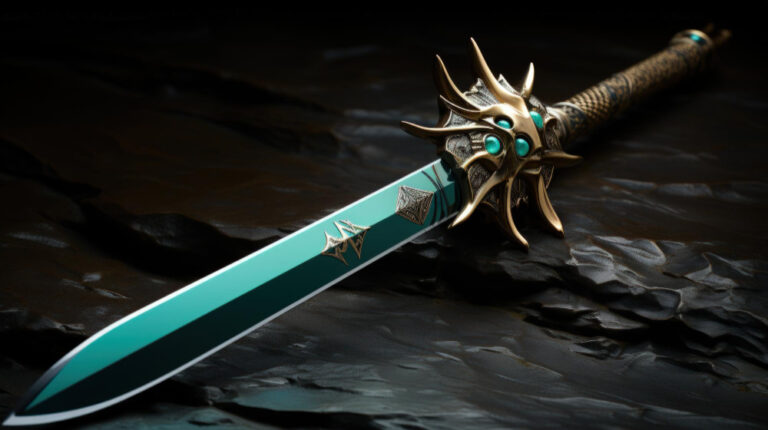The Viking Age (793–1066 AD) was a period marked by fierce warriors, legendary battles, and remarkable craftsmanship in weaponry. Among the many swords wielded by Norse warriors, the Honangen Sword stands out as a symbol of power, artistry, and historical significance. Discovered in Norway, this ancient weapon offers a glimpse into Viking metallurgy, combat techniques, and cultural values.
Discovery of the Honangen Sword
The Honangen Sword was unearthed in Honangen, Norway, a region known for its rich Viking heritage. According to the sword was found in a burial site, suggesting it belonged to a high-ranking Viking warrior or chieftain. Burial swords were often placed alongside their owners to accompany them into the afterlife, a common practice in Norse culture.
Archaeologists estimate that the sword dates back to the 9th or 10th century, a time when Viking raids and expeditions were at their peak. The preservation of the blade indicates advanced forging techniques, as many Viking swords have been found in fragments due to corrosion over centuries.
Design and Craftsmanship of the Honangen Sword
Viking swords were not just tools of war but also works of art. The Honangen Sword exemplifies the Ulfberht type, a prestigious class of Viking blades known for their superior steel quality.
1. The Blade
- Made from high-carbon steel, which was rare in Europe at the time
- Features a pattern-welded core, enhancing strength and flexibility
- The sharp, double-edged design allowed for both slashing and thrusting
2. The Hilt and Pommel
- The hilt (handle) is often decorated with intricate carvings or metal inlays
- The pommel (counterweight) balances the sword, improving handling
- Some Viking swords, including the Honangen, had runic inscriptions, possibly denoting the smith’s name or a protective charm
3. The Scabbard
- Typically made of wood and leather, sometimes lined with wool to prevent rust
- Often adorned with bronze or silver fittings for ceremonial purposes
The craftsmanship of the Honangen Sword suggests it was forged by a master smith, possibly from the Frankish Empire (modern-day Germany/France), where some of the finest Viking swords were produced.
Historical and Cultural Significance of Viking Swords
Swords were more than just weapons in Viking society—they were status symbols. Only the wealthiest warriors could afford a high-quality sword like the Honangen, as the process of forging one was labor-intensive and required imported materials.
1. Symbol of Power and Honor
- A sword was often passed down through generations as an heirloom
- Losing a sword in battle was considered a great dishonor
- Legendary Viking sagas, such as the Saga of the Volsungs, depict magical swords like Gram, highlighting their cultural importance
2. Ritual and Mythology
- Swords were sometimes given names, such as “Legbiter” (a famous sword of King Magnus III)
- Norse mythology speaks of enchanted blades, like Tyrfing, a cursed sword from the Poetic Edda
- Viking burials often included swords to ensure the warrior was armed in the afterlife
3. Trade and Influence
- Viking swords were traded across Europe and even reached the Middle East
- The Ulfberht swords (a group to which the Honangen may belong) were so prized that they were counterfeited
Comparison with Other Famous Viking Swords
The Honangen Sword shares similarities with other renowned Viking weapons:
| Sword Name | Origin | Notable Features |
| Honangen Sword | Norway | High-carbon steel, possible Ulfberht lineage |
| Ulfberht Swords | Frankish Empire | Inscribed with “Ulfberht,” superior steel |
| Sutton Hoo Sword | England | Anglo-Saxon, gold and garnet decorations |
| Sword of St. Peter | Poland | Legendary relic, said to have religious ties |
The Ulfberht swords are particularly noteworthy because they were made from crucible steel, a technique that was ahead of its time in Europe. If the Honangen Sword is indeed an Ulfberht, it places it among the elite weapons of the Viking Age.
The Legacy of the Honangen Sword in Modern Archaeology
The discovery of the Honangen Sword provides valuable insights into:
- Viking metallurgy – How Norse blacksmiths achieved such high-quality steel
- Trade networks – Evidence of material exchange between Scandinavia and the Frankish Empire
- Burial customs – The role of weapons in Viking funerary practices
Modern techniques like X-ray fluorescence (XRF) and 3D scanning allow archaeologists to study the sword without damaging it, revealing hidden inscriptions or manufacturing methods.
Conclusion: Why the Honangen Sword Matters
The Honangen Sword is more than just a relic—it is a testament to Viking ingenuity, artistry, and warrior culture. Its discovery helps historians piece together the lives of Norse warriors and the technological advancements of the time.
Whether it was wielded in battle, passed down as an heirloom, or buried with its owner for the afterlife, the Honangen Sword remains a fascinating artifact from one of history’s most formidable civilizations.
For more on Viking history and legendary weapons, check out the original article at The Would you like to own a replica of the Honangen Sword? Share your thoughts in the comments below! | actvid


